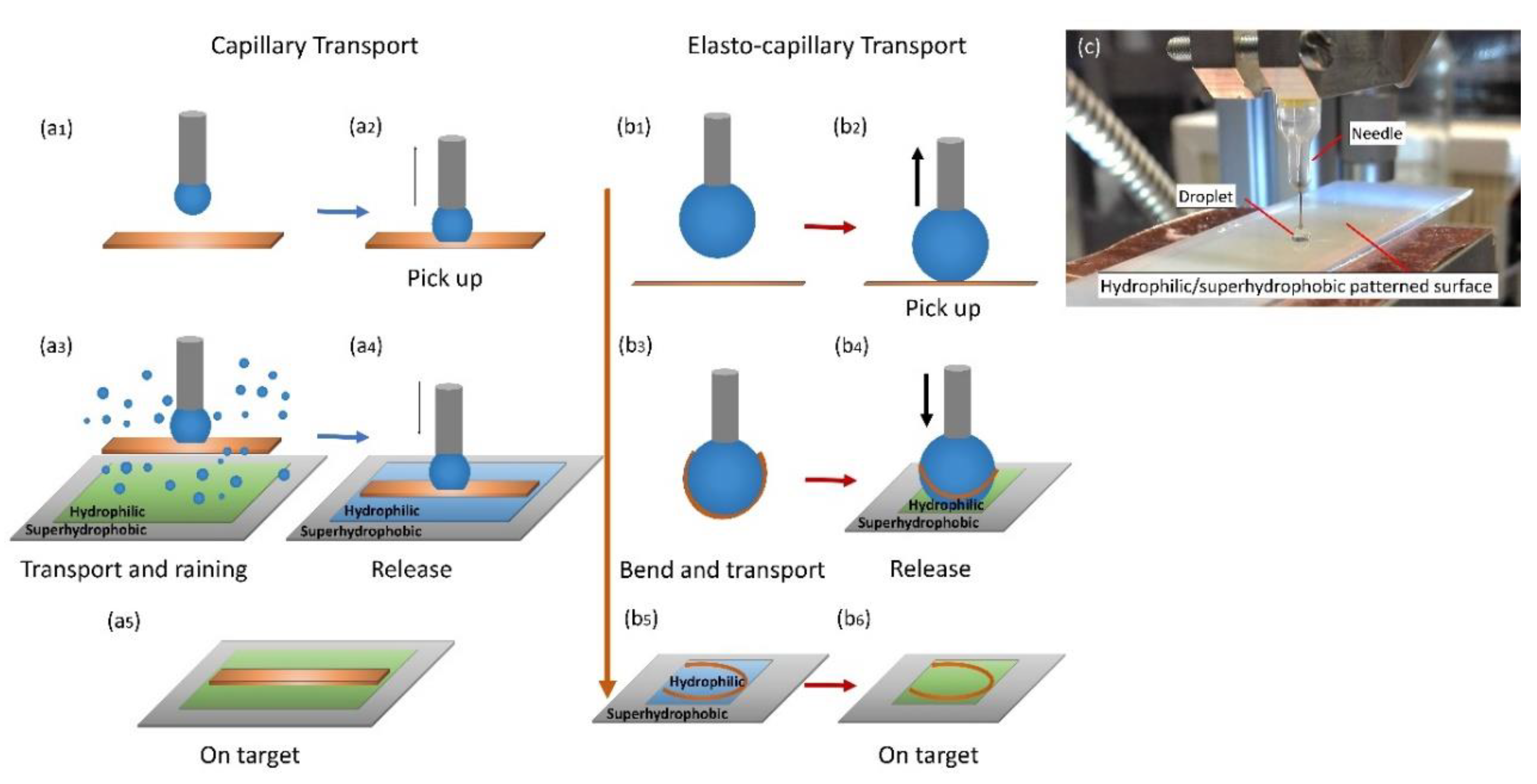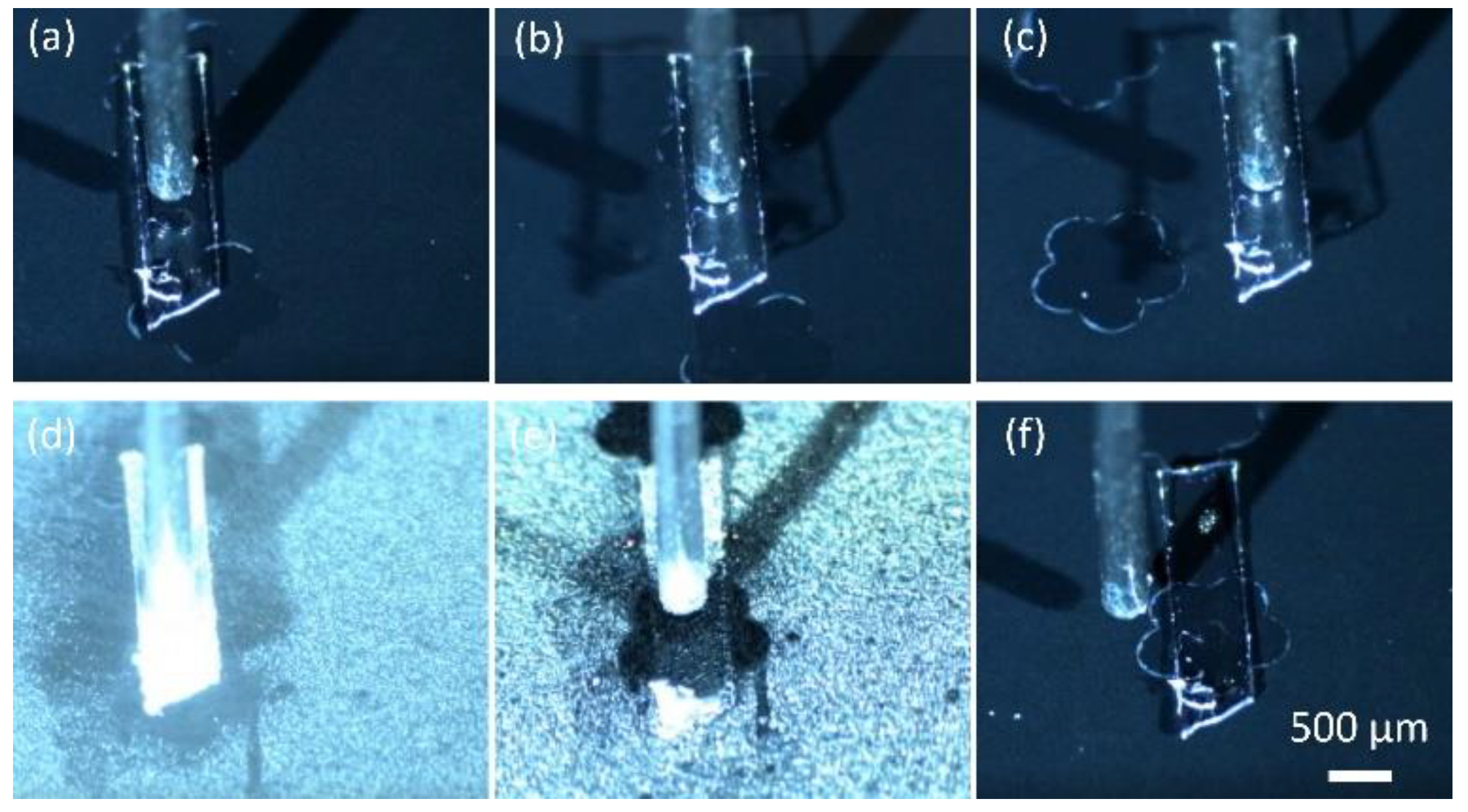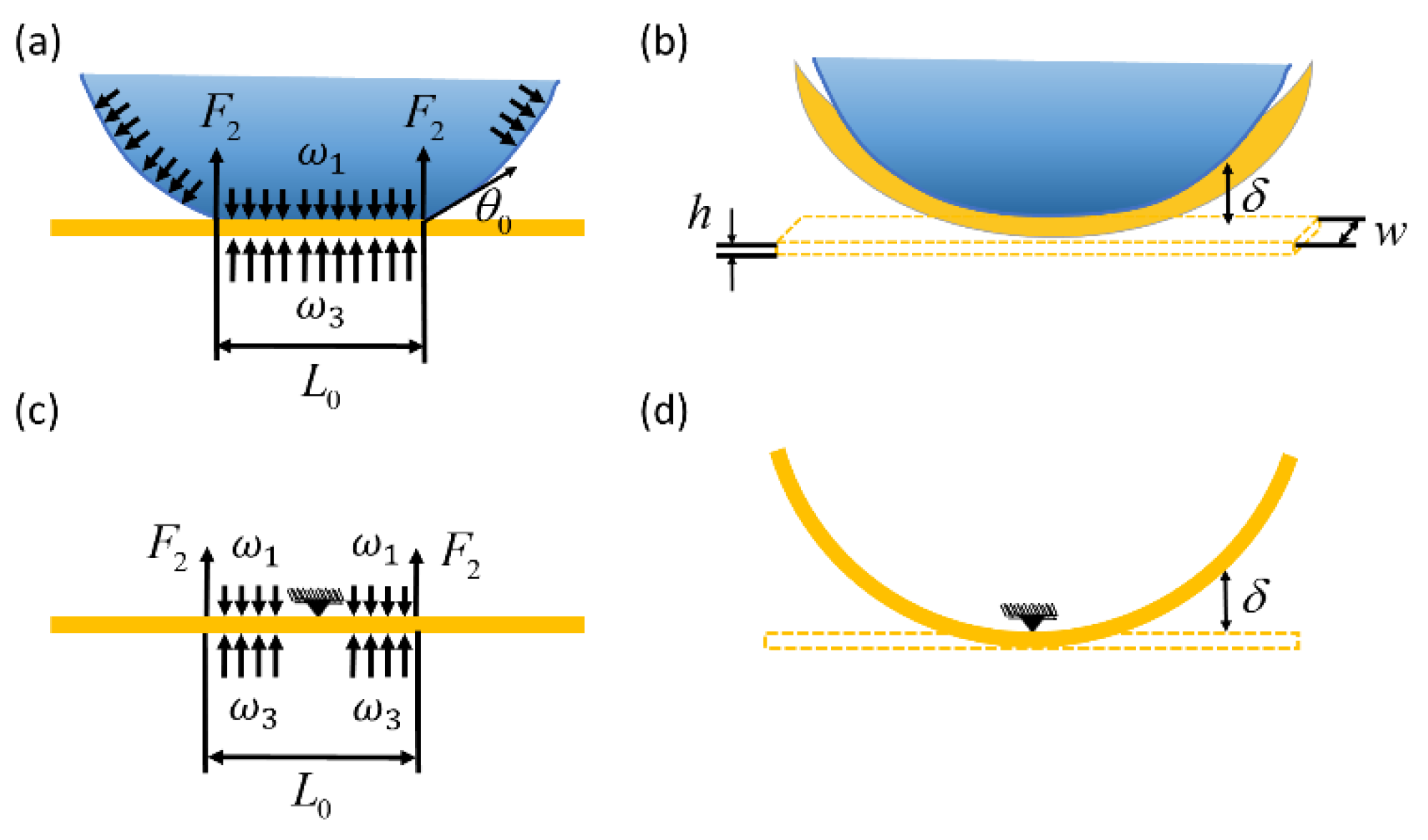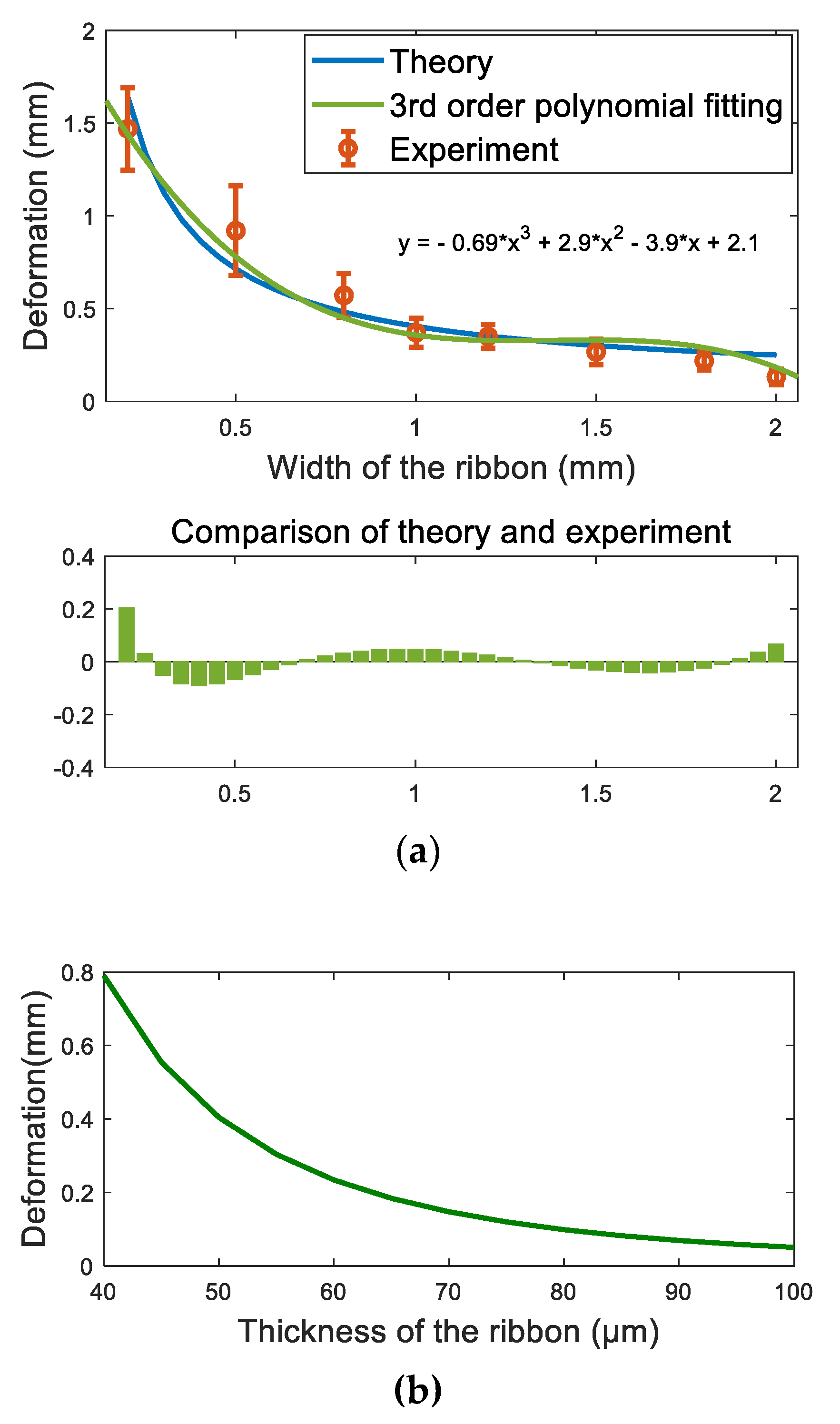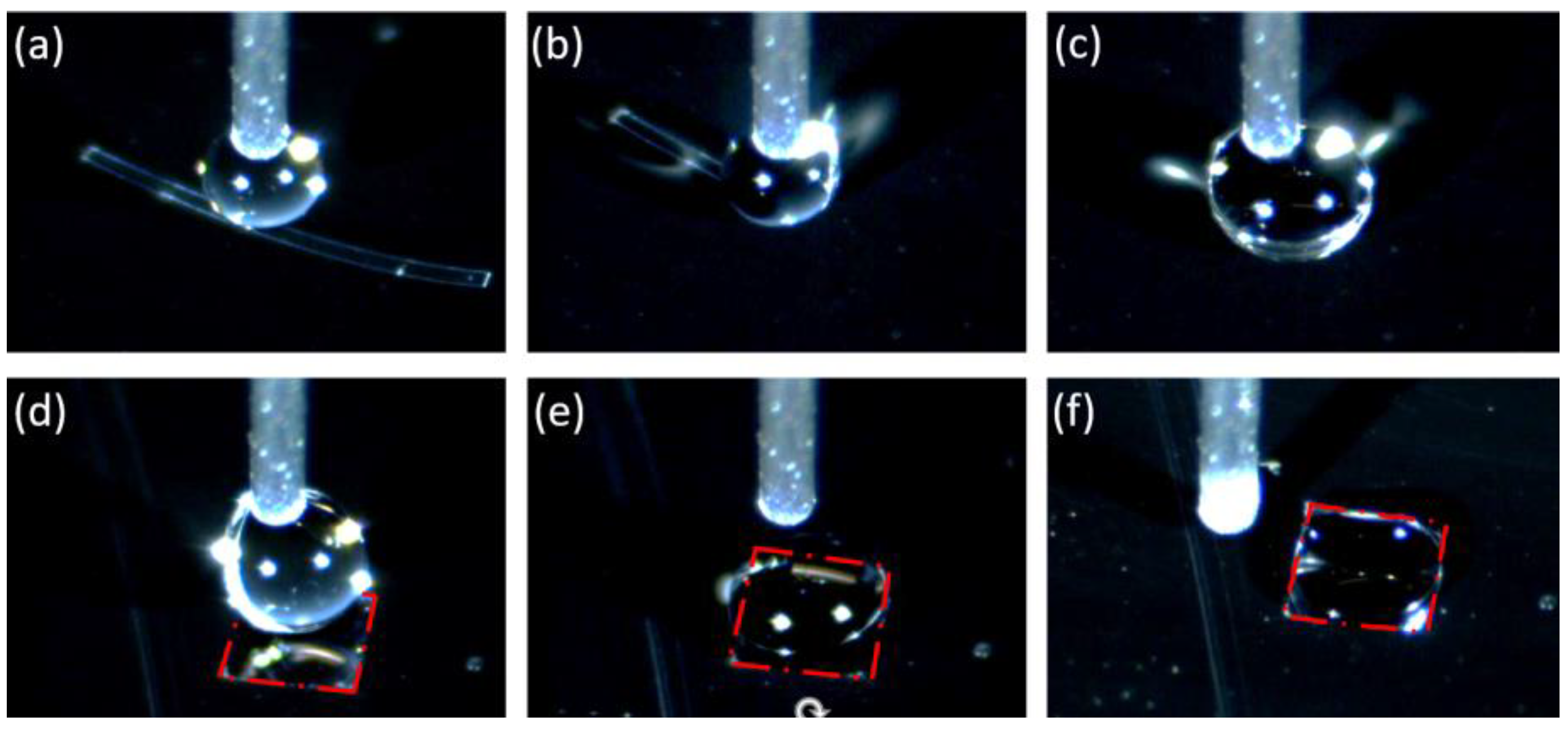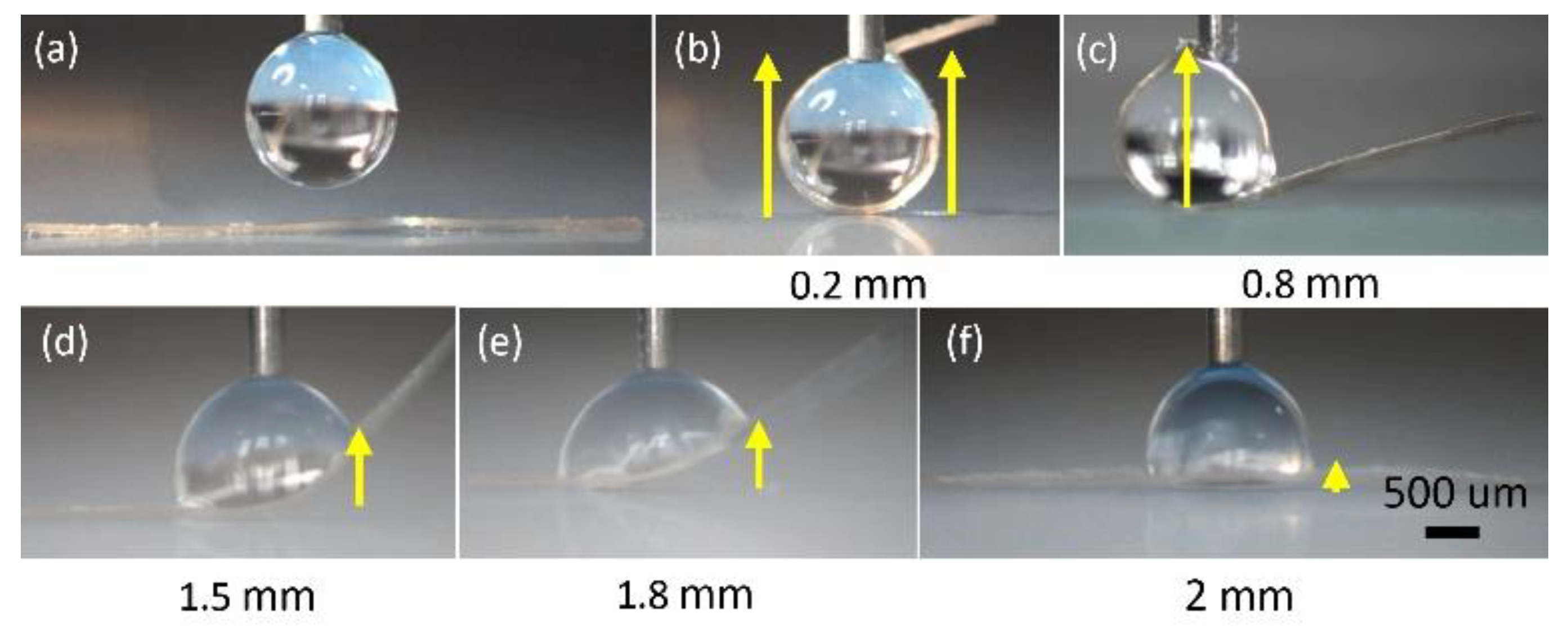3.1. Capillary Transport
When the needle contacts the soft ribbon, a liquid meniscus is formed between the needle and the elastic ribbon, as shown in
Figure 2. The ribbon can be picked up by the capillary force between the liquid meniscus and the ribbon. In such a case, we use ribbons with widths similar to the size of the manipulation droplet. Consequently, the radius of the contact area between the meniscus and the ribbon
is usually smaller than the width of the ribbon, so we can estimate the capillary lifting force
using an axial symmetric model. The capillary lifting force
consists of two components, the force caused by the pressure difference between the inside and the outside of the liquid meniscus
and the vertical component of the surface tension
. The capillary lifting force can be expressed as
where
is the surface tension of the liquid,
is the water contact angle on the ribbon,
is the radius of the contact area, and
is the pressure difference determined from Young-Laplace equation.
where
is the mean curvature of the meniscus,
and
are the principal radii of curvature. Based on the geometry of the meniscus, the mean curvature
can be expressed with respect to the coordinate of the meniscus
[
18].
Therefore, the capillary lifting force can be calculated if we know the exact shape of the meniscus. To estimate the shape of the meniscus, we developed a double iteration algorithm reported in an early publication [
19]. The algorithm starts with selecting a random starting point on the meniscus and setting the mean curvature, then the differential equation (Equation (3)) is solved, and the shape of the meniscus is obtained. After that, the contact angle on the ribbon is obtained and compared with the given contact angle. If the difference is less than the defined error interval, then the volume of the liquid is calculated. Otherwise, the mean curvature is reset. If the contact angle falls within the error interval, the volume of the liquid is calculated and compared with the given volume. If it is within the error interval, then the capillary lifting force is computed using Equation (1), otherwise the starting point is reselected.
Figure 3a shows the simulation of a water meniscus (0.15 μL) between a needle and a ribbon. Given the water apparent contact angle being 90° and 150° on the ribbon and the needle, respectively, and the distance between the needle and the ribbon 0.4 mm, the calculated capillary lifting force should be 0.15 mN.
Figure 3b shows the relationship between the capillary lifting force and the volume of meniscus. The simulation results indicate that the capillary lifting force increases as the volume of the meniscus increases.
To pick up the ribbon, the capillary lifting force
should be greater than the sum of the adhesion between the ribbon and the substrate
and the gravity of the ribbon
. Given the length of the elastic ribbon
L = 5 mm, the width
w = 2 mm, the thickness
h = 50 μm, the mass density of PDMS
= 965 kg/m
3, and the gravity of the ribbon can be estimated using
The adhesion force by surface unit between two solid surfaces mainly include van der Waals force, which can be expressed as [
20]
where
is the Hamaker constant, and
is the distance between the ribbon and the substrate, which can be considered in the order of nanometers [
20]. The calculated Hamaker constant between Nylon and solid PDMS is in the order of
[
21], so the adhesion force
should be in the order of micronewtons at the same level of gravity. Both forces jointly contribute less than 10% of the capillary lifting force
(0.1–0.2 mN), thus the ribbon should be picked-up easily.
For releasing of the ribbon, water mist is introduced on the hydrophilic substrate and a water meniscus is formed between the ribbon and the substrate as shown in
Figure 4. Given the water contact angle on the ribbon and the hydrophilic substrate
,
, the height of the meniscus
, the volume of the liquid 4 μL, the releasing force
should be around 114 mN, which is three orders of magnitudes greater than the capillary lifting force
(0.15 mN). Therefore, the ribbon releases rather deterministically.
Figure 5 shows the capillary releasing force as the function of the volume of the meniscus and the contact angle on the substrate, where
x-axis represents the contact angle on the substrate, and
z-axis represents the capillary releasing force. The releasing force increases as the volume of the meniscus increases and the contact angle on the substrate decreases. The simulation indicates that the releasing mainly depends on the volume of the liquid film between the ribbon and the hydrophilic site and the water contact angle on the hydrophilic site.
Figure 6 shows the sequences of picking up and releasing of a ribbon. First, the ribbon is moved under the needle (
Figure 6a), and then a droplet is produced by the needle and the ribbon is picked up (
Figure 6b). Next, the ribbon is transported to the target site, and water mist is introduced to the site (
Figure 6c,d). Finally, the ribbon is released on the target, and the droplets evaporate (
Figure 6e,f).
3.2. Elasto-Capillary Transport
Based on the scaling laws, capillary force is proportional to length
, elastic forces are proportional to
and body forces such as gravity is proportional to
. When all the dimensions scale down, capillary force decreases the slowest compared to elastic forces and gravity force. Therefore, in micro scale, when a drop is in contact with an elastic ribbon and the width of the ribbon is much smaller than the size of the droplet, the capillary force will eventually overcome the elastic force and bend the elastic ribbon, as shown in
Figure 7.
The bending of the ribbon can be modelled as the deflection of a cantilever beam given that the droplet is dispensed in the middle of the ribbon. As shown in
Figure 7,
is the contact length of a droplet with the elastic ribbon,
and
are width and thickness respectively.
is the deformation of the ribbon, which is defined as the distance between the middle of the ribbon and the water–ribbon contact line. The bending force acting on the elastic ribbon consists of three parts, one is the uniformly distributed load
caused by Laplace pressure
, and the second part is the concentrated load
, which is the vertical component of the surface tension along the width of the ribbon and can be calculated as
. The last part is the uniformly distributed load
which is also the vertical component of the surface tension along the contact length
. Therefore, the deformation can be calculated using Equation (6).
where
is Young’s modulus of the elastic ribbon,
is the surface tension,
is the moment of inertia of an elastic ribbon, which can be expressed as
,
, is the water contact angle on the ribbon. The blue curve shown in
Figure 8a represents the deformation of the ribbon as the function of the width and thickness, which is calculated using Equation (6), given the water contact angle on the ribbon
, Young’s modulus of PDMS
= 3.2 MPa, the width of ribbon
, and the thickness of the ribbon
. The deformation of the ribbon is clearly affected by both the width and thickness. The deformation of the ribbon decreases as the width of the ribbon and the thickness increase.
Figure 9 shows the sequences of picking up and releasing of a 0.2 mm wide ribbon based on elasto-capillary phenomenon. First, the ribbon is moved below the needle (
Figure 9a), and then a droplet is produced by the needle. Next, the ribbon bends and is picked up by the needle (
Figure 9b,c). After that, the ribbon is transported to a hydrophilic target site, which is highlighted with red dot lines (
Figure 9d). Finally, and water droplet is in contact with the hydrophilic site, forming a liquid film, and the ribbon is released on the target (
Figure 9e,f).
To verify the theoretical estimations of the deformation as the function of the width of the ribbon shown in
Figure 9a, a series of tests were carried out to study the influence of the width of the ribbon on the deformation. In the tests, the length of the ribbon was kept same as 5 mm, the thickness of the ribbon is 50 µm, and the contact angle of the water on the PDMS is 90°. Ribbons with widths of 0.2 mm, 0.5 mm, 0.8 mm, 1.0 mm, 1.2 mm, 1.5 mm, 1.8 mm, and 2 mm were tested. The same amount of the droplet (1 µL) was dispensed at the middle of the ribbon for each test, and each test was repeated five times. The deformation was measured as the distance between the middle of the ribbon and the water-ribbon contact line. The experimental results are shown in
Figure 8a and compared with the theoretical estimations. The theoretical estimations are given based on Equation (6). The orange circles with error bar represent the experimental data, which consists of mean of five repetitions with standard derivation. The green curve is the third order polynomial fitting of the experimental data and the blue curve represents the theoretical estimations. Both experimental results and theoretical estimations show that the ribbons with widths from 0.2 mm to 2 mm all bend, and as the width of the ribbon increases, the ribbons deform less. The experimental data matches the theoretical estimations well, and both indicate that the ribbon with smaller width produces larger deformation. Equation (6) is a well-known equation for calculating the deflection of a cantilever beam in mechanical design, our study verifies that Equation (6) is also valid for calculating deformation of soft ribbons, which has not been reported before.
Figure 10 shows examples of the deformation of the ribbon as the width of the ribbon increases from 0.2 mm to 2 mm. First, a droplet is dispensed at the middle of the ribbon by a needle (
Figure 10a). Then, a meniscus is formed, and the ribbons with different widths all bend (
Figure 10b–f).
